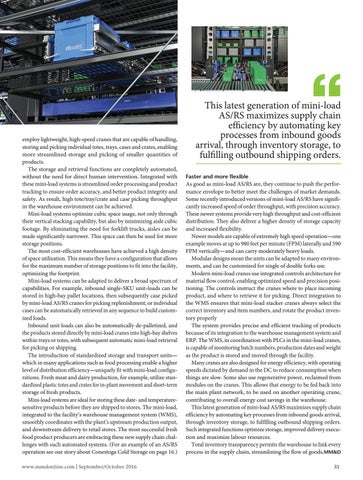employ lightweight, high-speed cranes that are capable of handling, storing and picking individual totes, trays, cases and crates, enabling more streamlined storage and picking of smaller quantities of products. The storage and retrieval functions are completely automated, without the need for direct human intervention. Integrated with these mini-load systems is streamlined order processing and product tracking to ensure order accuracy, and better product integrity and safety. As result, high tote/tray/crate and case picking throughput in the warehouse environment can be achieved. Mini-load systems optimize cubic space usage, not only through their vertical stacking capability, but also by minimizing aisle cubic footage. By eliminating the need for forklift trucks, aisles can be made significantly narrower. This space can then be used for more storage positions. The most cost-efficient warehouses have achieved a high density of space utilization. This means they have a configuration that allows for the maximum number of storage positions to fit into the facility, optimizing the footprint. Mini-load systems can be adapted to deliver a broad spectrum of capabilities. For example, inbound single-SKU unit-loads can be stored in high-bay pallet locations, then subsequently case picked by mini-load AS/RS cranes for picking replenishment, or individual cases can be automatically retrieved in any sequence to build customized loads. Inbound unit loads can also be automatically de-palletized, and the products stored directly by mini-load cranes into high-bay shelves within trays or totes, with subsequent automatic mini-load retrieval for picking or shipping. The introduction of standardized storage and transport units— which in many applications such as food processing enable a higher level of distribution efficiency—uniquely fit with mini-load configurations. Fresh meat and dairy production, for example, utilize standardized plastic totes and crates for in-plant movement and short-term storage of fresh products. Mini-load systems are ideal for storing these date- and temperaturesensitive products before they are shipped to stores. The mini-load, integrated to the facility’s warehouse management system (WMS), smoothly coordinates with the plant’s upstream production output, and downstream delivery to retail stores. The most successful fresh food product producers are embracing these new supply chain challenges with such automated systems. (For an example of an AS/RS operation see our story about Conestoga Cold Storage on page 16.) www.mmdonline.com | September/October 2016
30-31_MMD_SeptOct2016_ASRS.indd 31
This latest generation of mini-load AS/RS maximizes supply chain efficiency by automating key processes from inbound goods arrival, through inventory storage, to fulfilling outbound shipping orders. Faster and more flexible
As good as mini-load AS/RS are, they continue to push the performance envelope to better meet the challenges of market demands. Some recently introduced versions of mini-load AS/RS have significantly increased speed of order throughput, with precision accuracy. These newer systems provide very high throughput and cost-efficient distribution. They also deliver a higher density of storage capacity and increased flexibility. Newer models are capable of extremely high speed operation—one example moves at up to 980 feet per minute (FPM) laterally and 590 FPM vertically—and can carry moderately heavy loads. Modular designs mean the units can be adapted to many environments, and can be customized for single of double forks use. Modern mini-load cranes use integrated controls architecture for material flow control, enabling optimized speed and precision positioning. The controls instruct the cranes where to place incoming product, and where to retrieve it for picking. Direct integration to the WMS ensures that mini-load stacker cranes always select the correct inventory and item numbers, and rotate the product inventory properly The system provides precise and efficient tracking of products because of its integration to the warehouse management system and ERP. The WMS, in coordination with PLCs in the mini-load cranes, is capable of monitoring batch numbers, production dates and weight as the product is stored and moved through the facility. Many cranes are also designed for energy efficiency, with operating speeds dictated by demand in the DC to reduce consumption when things are slow. Some also use regenerative power, reclaimed from modules on the cranes. This allows that energy to be fed back into the main plant network, to be used on another operating crane, contributing to overall energy cost savings in the warehouse. This latest generation of mini-load AS/RS maximizes supply chain efficiency by automating key processes from inbound goods arrival, through inventory storage, to fulfilling outbound shipping orders. Such integrated functions optimize storage, improved delivery execution and maximize labour resources. Total inventory transparency permits the warehouse to link every process in the supply chain, streamlining the flow of goods.MM&D 31
2016-09-29 4:50 PM
